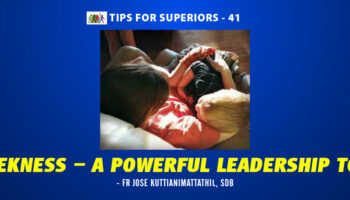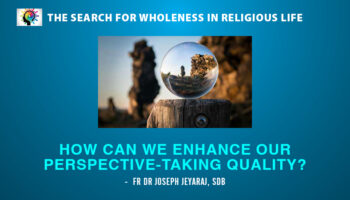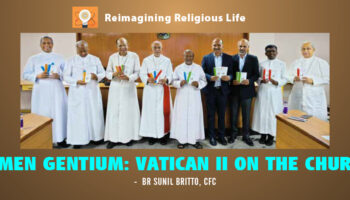You may have heard the joke about a religious telling his provincial: “In this community we have a few saints, and the rest are martyrs!” The reference is to the disappointing (at times scandalous) reality that a person may be meticulous about the practices of piety or even spend long time in church, but be extremely difficult to live with, or lacking in compassion, love or generosity.
Once someone asked Don Bosco what he thought of the spirit of prayer in a particular community. He replied he would tell them in a few days. The reason: Don Bosco believed that anyone can look pious in church; that one’s prayer life is seen more in one’s spontaneous behaviour and remarks. In the case of boys, he referred to the dining room and the playground—the two places where a boy shows what he is truly like.
To explain what spirituality really is, I would like to use the case of a religious sister. Let us call her Sr. Jane.
Sr. Jane asked herself some central questions: What is spirituality in practice? Who is a “spiritual” or holy person? After all, holiness cannot be measured like temperature, nor taught, like English grammar or mathematics.
She is also disturbed by two experiences. One, that her family members (who have not had novitiates, daily Mass and meditation, monthly recollections and annual retreats) are often more God-centred and Christ-like. Secondly, we live in a country noted for its external religiosity—large crowds at churches, temples and mosques; pilgrimages to religious shrines—but which is also marked by deep corruption. One day, an educated woman told her: “My husband knows a lot of prominent people in the city. Some of the most corrupt are also the most ‘religious.’ So, he prefers to be an atheist.”
Personally, Sr. Jane is also looking for more enthusiasm and freshness in her commitment. She is doing her work honestly, but she often feels that there is no “fire” in her; that a real passion for God is missing.
She feels challenged by Susan and Hilda, two of her companions who are working among the poor. They tell Jane: “These poor people are much more God-oriented than many of us. We learnt more about spirituality from them, than they from us.”
Talking to younger religious and some seminarians and priests, she finds that they are tremendously impressed by persons like Medha Patkar (who so courageously defends the poor people displaced and dispossessed by the large dams), Abdul Kalam, our much-loved former president, Harsh Mander (who resigned from IAS, in the wake of the anti-Muslim pogrom in Gujarat). Such women and men are shining examples of integrity and commitment. Isn’t that spirituality?
She started reading up on spirituality. She is amazed to discover the tremendous range of writings on spirituality— everything from Biblical to Patristic to Liberation to Feminist to Indian to Youth to the spirituality of married couples and children. She had no idea there are so many approaches to spirituality.
Among the authors she read, Jane was particularly impressed by Donal Dorr, an Irish Missionary who works in Africa. Dorr is aware of the tension between the contemplatives and the activists in the church, and their mutual critique. He presents an integral spirituality, which has three main dimensions.
Dorr calls the personal dimension “religious conversion” or conversion to God. If I trust in God, I will be a person of integrity. It is in God’s providence that I trust, not in money or crookedness. We cannot claim to trust God or be Godcentred, and do crooked things at the same time. God cannot ask me to cheat others, or tell lies. God’s interest is not simply that I sing hymns in church. As Psalm 37 says, “Trust in the Lord, and do good.” It asks us not to follow the paths of the crooked.
Secondly, at an interpersonal level, spirituality is expressed as love—a forgiving and active love, as Jesus taught by word and example. This hardly needs explanation. In a family or religious community, we know very soon who is loving and who is selfish, whom we can count on when we need help, and who will not lift a finger to help others. One good example of spirituality that comes to my mind is of a superior who faced calumnies very calmly. When I expressed my admiration for this attitude, he told me, “When someone speaks ill of me, I pray extra for that person; this way, I have never lost my peace of mind.”
The third is the social level. This is the structural or organized level of our life, where justice is the main issue. Since people often suffer injustice on the basis of money, gender or race/caste, the truly spiritual person will make sure to avoid any such discrimination or injustice. If I am unjust, I cannot be spiritual or godly. Thus, if I am a religious superior or employer, iis not enough I pray for my employees, or smile at them; I have the duty to see that they are paid a just salary, and that their working conditions are proper. So, too, I cannot discriminate against someone of the basis of money, gender or ethnicity. If I am a linguistic bigot or a caste fanatic (putting down others belonging to a different group), I cannot call myself spiritual or a disciple of Jesus.
Linked to integrity and justice is the whole area of ecology, which, Jane realized, is such a pressing moral and spiritual issue. Now she understands how important it is—to care for the planet, our common home.
If spirituality is such an all-embracing reality, Jane realizes she can learn it from good, honest people and from courageous activists, from deeply prayerful people and from deeply compassionate caregivers. She sees that prayer is not opposed to the action for justice; the two are closely linked. In fact, she understands the meaning of prayer more correctly. Prayer is not just saying some formula, or spending hours in church, but truly listening to God with her whole heart, eager to listen, and eager to do what God asks. She sees what a great model of prayer Our Lady is. At the Annunciation, Mary listened to God and said Yes, and then rushed to help Elizabeth who was in need.
Jane got into her annual retreat with greater eagerness. The spiritual path seemed to her such a thrilling adventure—to get to know her own potential and inner strength more fully, to become a person of integrity, to grow in love, to stand for justice. She met Sister Bernardine, an excellent retreat director and scripture scholar, who told her that her quest was right on target, that, according to the Bible, the inner experience of God and the practice of justice are deeply linked. Sr. Bernardine encouraged Jane to meditate on Psalm 14 (15). The psalm makes holiness consist in right relationships—avoiding slander and calumny, usury and bribes.
Sr. Jane was also helped by a friend who loves this verse from prophet Micah (6:8): “This is what God asks of you: that you do justice, that you love, that you walk humbly with God.”
Jane now feels a new enthusiasm and a new respect for herself. She knows that integrity is central, and that is her own responsibility. She reaches out to others with greater thoughtfulness and love, apologizes when she hurts someone, and prays for those who hurt her. She tries to bring more into her dealings. She also stands for justice, speaks up for the poor, or on women’s issues, and fights all caste discrimination. She teaches her students care for the environment.
Jane now feels more alive, finds life more meaningful; Jesus’ words and life provide a silent but powerful support and inspiration for this journey. Each day brings new challenges, and fresh opportunities. Others notice the sparkle in Jane’s eyes, and remark how life-giving her presence is Many of them say: “I want to be more like Sr. Jane.”
To read the entire article, click Subscribe






